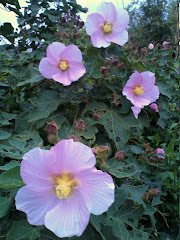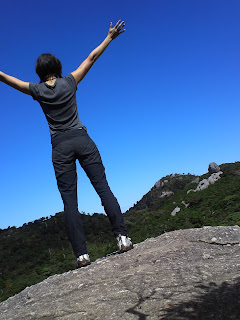Oct 18-19, 2012
Yodogawa -> Mt. Miyanoura -> Shin-Takatsuka hut -> Jomon Sugi -> Shiratani -> Kusukawa
淀川→宮之浦岳→新高塚小屋→縄文杉→白谷→楠川
So the typhoon cleared out faster than everyone expected, and I hopped a bus to the mountains, intending to retrace half the route I took my first trip to Yakushima. Japanese hikers like to get started early, and the trail was empty by the time I got to the entrance to the Yodogawa Trail.
台風の後の天気は一番ですね。だから18日、バスに乗って山に向かった。始めて屋久島に来た時のコースの一部を歩くつもり。出発が遅いから、淀川登山口に着いたら、人は少ない。
The skies are so blue. In this land where it rains "35 days a month", today is the first time I've been able to see "Tofu Rock" atop Mt. Kohban. I hadn't even known that mountains overlooked Hananoego, the high-altitude peat marsh.
月35日が雨と言われている屋久島だけど、今日は頭上は一つ雲もない青空。始めて高盤岳の豆腐石や花の江川から見えるはずの山々が見える。
And then, the outlook where I fell in love with Yakushima. The first time I was here, 3 years ago, it was about 5:30am, and the world below glowed with mountains poking up from an orange fog.
そうして、三年前、屋久島を一目惚れした展望台。その時は朝の5:30の朝日に染めたオレンジ色の霧から浮かび上がった山を眺めてた。。
I meet a group of about 30 senior citizens doing a one-day roundtrip to Mt. Miyanoura (altitude=1937m). Why do people come from so far to climb Mt. Miyanoura? This is why: A 360 degree view of Yakushima with funny granite boulders dotting the green mountains surrounded by ocean. I'm alone at the top, and I have a nice little cry. When I sit down next to the peak marker, the wind dies down, and it's perfectly silent. I can hear only the feint ringing of my ears.
途中で、日帰りのトレッキングから帰って来た約30人の年配の方と出会った。すごいな、、、宮之浦岳は標高1937mの山だよ。なんでそんな年でもわっざわざ登らなきゃの?もちろん山頂からの眺めが素晴らしいからです。360°の海、周りの緑な山岳から出っ張る花崗岩。涙。今一人だ。しゃがんだら、風が急に消えて、静かになる。自分の耳鳴り以外の音は全くない。



I meet all kinds of animals: numerous deer and monkeys, a weasel, and several interesting birds such as the Japanese Wood Pigeon and the Eurasian Jay.
屋猿、屋鹿、コイタチ、カラスバトやカケスと出会う。
When I get in to Shin-Takatsuka hut, it's already getting dark. Someone has started a small fire--off the scale of things you shouldn't be doing in this area of Yakushima--but it's been burning for a while and I let it go. Besides, it's cold and the company is nice. Most of the folks staying in this hut have come up the trail from the Jomon Sugi tree, and they're hoping to see the sunrise over Mt. Miyanoura. I'm tempted to join them, but today I'm planning my descent down a trail I haven't walked before. For breakfast, I eat a package of boiled chestnuts someone had dropped around Mt. Miyanoura, and head out around sunrise.
新高塚小屋に着いたら既に薄暗い。誰かたき火をしてる。この場所ではもちろん激禁だけど、もう遅いし、寒いし、心地よい。新高塚に泊まる人はだいたい宮之浦岳の周辺から日の出をみたいんだ。私もそうしようかなと迷ったけど、今日は新しい山道が待ってる。朝ご飯には、誰かが落ちた栗の一袋。そうして出発。

From Shin Takatsuka hut, it's not far to Jomon Sugi, and by now I know the Okabu Hodo (aka the Jomon Sugi Route) like the back of my hand. It's full of great sights like Wilson's Stump and the Husband-and-Wife Sugi trees, but when I'm on my own none of that matters, and I can soak in the feel of the overall forest. It's a pleasant stroll down with my headphones on. This would be a great trail for trail running, but there's too many people most of the time.
新高塚小屋から縄文杉まで遠くはないし、そこからおりる大株歩道はよく知ってる。今日は有名なウイルソン株や夫婦杉などはどうでもいいから、音楽を聞きながら森の全部を楽しみながら散歩する。
Soon I'm on the railroad tracks, pausing to greet the guides and let them pass with their clients on the way up. I turn off the tracks at the branch to Shiratani. Shiratani is full of up-down trails, and I'm a bit tired, but everything is so green, and the weather is perfect.
そろそろトロッコ道に出て、縄文杉に向かってるガイドさんと軽く挨拶しながら、白谷の分かれまで歩き続く。白谷はやはりアップ・ダウンが多いけど、緑できれい。天気も最高。
As planned, I veto the normal bridge towards the parking lot, and head down the old stone trail the loggers used in Edo times. It's a long trail down that ends just a couple kilometers from the ocean, and it's full of slippery pebbles and stones, and I just realized my new shoes are too short. . . but the trail has been recently cleared, and it follows the beautiful Kusukawa river. This could be a mountain river in Anywhere, Japan. And that's why I love Japan.
駐車場の道の代わりに今日は楠川歩道を歩く。江戸時代にできた石の道だそうだ。長い、歩きづらい小石ばっかりだし、私の新しい靴が短すぎる、、、でも!この山道は最近に掃除されたり直されたりしたようだし、楠川はとっってもきれい!この川は日本の各地にある川とあまり変わらない。だから日本が好きだよ!


When I reach the town below, there's a lady airing out some mattresses. She runs inside as I pass. But then she comes running back out with a bunch of "kakarandango," a sweet confection of mochi wrapped in a leaf.
町に辿り着いたら、布団を干してる女が速く家に消えてしまう。そうして、かからん団子を持って、私の後に声をかけてくる。わ~~嬉しいな。ありがとうございます!
だから屋久島が好きだよ!
And that's why I love Yakushima.

















































